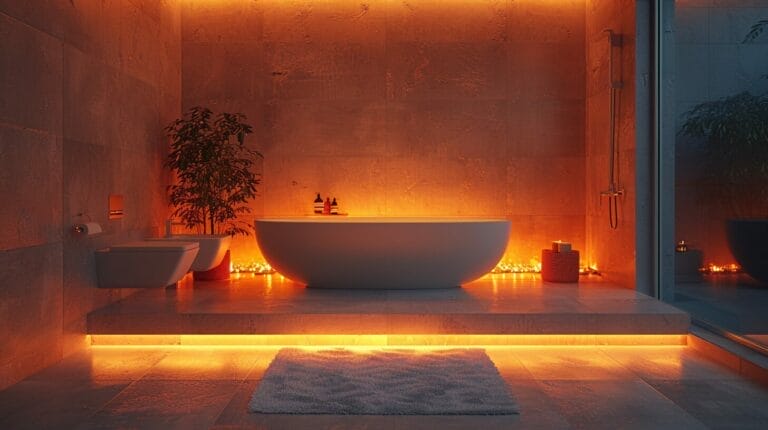Side Effects of LED Lights: Illuminating Insights
As we explore the world of LED lights, it becomes apparent that there are more than meets the eye when it comes to their impact on our well-being. While the energy efficiency and longevity of LEDs are undeniable, the side effects they carry are worth our attention. From the subtle disturbances in our sleep patterns to the potential triggers for headaches, these illuminating insights prompt us to ponder the broader implications of our lighting choices.
Let’s shed light on the intricacies of LED light utilization and explore how we can strike a balance between reaping the benefits and safeguarding our health.
Key Takeaways
- Blue light from LED lights disrupts sleep patterns.
- Flicker effect in LED lights can cause headaches.
- Lack of UV in LED lights affects vitamin D synthesis.
- Strategies can mitigate LED light health risks.
- Elderly are more vulnerable to LED light side effects.
Understanding the Science Behind LED Lights

LED lights operate based on electroluminescence, where electricity excites electrons in a semiconductor material to emit light. They emit a spectrum of light that can impact our health and well-being. A key aspect to consider is the correlated color temperature (CCT) of LED lights, which determines the light’s color appearance. This CCT influences how LED lights affect our retinas and, consequently, our circadian rhythms.
Research suggests that exposure to certain types of LED light, especially those with high CCT values, can disrupt our circadian rhythms by suppressing melatonin production. This disruption can lead to health effects like sleep disorders and fatigue. Understanding this interaction between LED lights and our retinas is crucial for creating lighting solutions that foster both productivity and well-being.
Identifying Potential Health Risks of LED Lights

Exposure to blue light from LED lights can disrupt sleep patterns and cause eye strain as it interferes with melatonin production, affecting our circadian rhythm. Moreover, the flicker effect in some LED lights, though imperceptible to the naked eye, can cause headaches and visual discomfort in sensitive individuals. Lastly, the lack of an ultraviolet component in LED lighting may affect vitamin D synthesis in individuals who are exposed to these lights for extended periods indoors.
Focusing on the Elderly: Special Considerations for LED Light Usage

The elderly may be more susceptible to the side effects of LED lights due to factors such as changes in eye structure and decreased melatonin production. It’s crucial to expose them to appropriate levels of LED light to prevent any adverse effects. When choosing LED bulbs or fixtures for elderly individuals, opt for warm white light with lower color temperatures to reduce glare and eye strain. Adjustable LED lights that allow for varying brightness levels can accommodate their specific needs.
Mitigating the Side Effects of LED Lights

Considering the potential impact of LED lights on individuals, especially the elderly, it becomes imperative to explore strategies for mitigating any associated side effects effectively. To address these concerns, we propose the following innovative approaches:
- Utilizing Dimmers: Incorporating dimmer switches can offer a practical solution to control LED brightness levels, allowing for personalized lighting preferences and minimizing potential discomfort.
- Opting for Natural Spectrum LEDs: Selecting LED bulbs that closely mimic natural light spectrum can enhance visual comfort and reduce strain on the eyes, promoting a healthier lighting environment.
- Implementing Screen Breaks: Taking regular breaks from LED screens or tablets can help alleviate eye fatigue and reduce the impact of prolonged exposure to artificial light, fostering overall well-being.
Exploring Alternatives to LED Lights

Alternatives to LED technology, like fluorescent lamps and incandescent bulbs, can cater to diverse lighting needs and preferences. Fluorescent lamps offer a bright and energy-efficient alternative to LEDs, coming in various color temperatures for customization based on the desired ambiance. Incandescent bulbs, though less energy-efficient, provide a warm glow that some may prefer over the cooler tones of LED lights.
Maximizing natural light through strategic window placement and reflective surfaces reduces dependence on artificial lighting, lessens energy consumption, and provides a connection to the outdoors that artificial lighting can’t replicate. These innovations in lighting technology offer alternatives to LED lights, enabling individuals to choose lighting solutions that best suit their needs while minimizing drawbacks associated with LED technology.
Conclusion
To sum up, it’s crucial for us to be aware of the potential health risks associated with LED lights and to take steps to mitigate these side effects.
By understanding the science behind LED lighting and implementing strategies to minimize negative impacts, we can enjoy the benefits of LED lights while ensuring our well-being.
Remember to prioritize your health and make informed choices when it comes to lighting options.
Frequently Asked Questions
Are LED lights safe for use?
Yes, LED lights are safe for use as they do not emit harmful ultraviolet or infrared rays like other types of lighting.
What are the potential side effects of exposure to blue light from LED screens?
Prolonged exposure to blue light from LED screens can disrupt circadian rhythms and affect the quality of sleep.
Can LED bulbs emit flicker? Is it harmful?
LED bulbs can emit flicker at a high frequency, which may not be harmful to everyone but can cause discomfort or health issues for some individuals.
How do LED lights compare to traditional light bulbs in terms of energy efficiency?
LED lights are more energy efficient compared to traditional light bulbs, consuming less electricity while producing more light output.
Is it safe to use dimmer switches with LED fixtures?
Not all LED fixtures are compatible with dimmer switches, so it is important to check with the manufacturer to ensure safe and proper usage.







